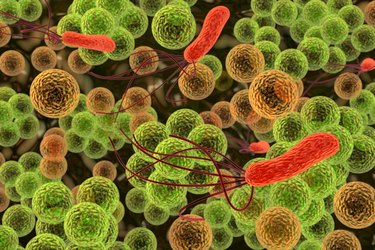
Bacteria cells function quite differently from human cells, from the function of the cell as a whole, right down to the individual structures in each cell. Bacteria exist in nature as individual cells. While some bacteria work together in a group, no bacteria forms multicellular tissues. Bacteria have organized structures within the cell, but do not have membrane-bound organelles, as with human cells.
Bacterial Cell Function
Video of the Day
In the grand scheme of things, the function of each bacterial cell begins and ends with collecting enough nutrients to survive. Bacterial cells consist of a phospholipid bilayer, and in some cases a layer of peptidoglycan. The phospholipid bilayer either allows or denies ions and other molecules entry to the cell, based on factors such as size and charge. The peptidoglycan, while not technically a cell wall, serves a similar function by protecting against the osmotic gradient created across the phospholipid bilayer.
Video of the Day
Genetic Material
In human cells, deoxyribonucleic acid (DNA) gets produced in the membrane-bound nucleus. DNA from bacterial cells resides throughout the interior of the cell, in the cytoplasm. The main function of DNA in bacterial cells is the same as human cells, transcription into ribonucleic acid (RNA) followed by translation into amino acids and subsequent folding into proteins.
Ribosomes
Ribosomes exist in the cytoplasm of a bacterial cell and have a very important function. Ribosomes translate the amino acids from RNA. Once translated, the amino acids fold up into tertiary structures called proteins. The proteins in a bacterial cell have many important functions, including regulation of transcription and translation, and becoming transmembrane proteins for help in relocation of necessary nutrients that are too large or charged to pass across the phospholipid bilayer.
Flagella
Flagella help bacteria move through the environment. The flagellum is a whip-like structure that can occur at one end, both ends, or all over the bacterial cell. The whipping action pushes the bacteria through the aqueous solution and improves the cells' chances of being in a nutrient-rich environment.
Endospores
Some species of bacteria contain an endospore. Endospores are a bacteria cell's way of protecting itself against harsh changes in the environment or nutrient depletion. When a required nutrient in the environment becomes depleted or absent, signals get sent to the bacteria to begin endospore formation. An endospore protects the bacterial genetic material so that, when optimal conditions return, the bacterial cell can reform and thrive again.